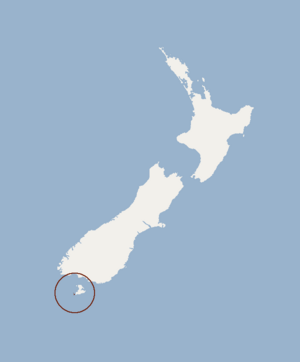New Zealand greater short-tailed bat facts for kids
Quick facts for kids New Zealand greater short-tailed bat |
|
|---|---|
 |
|
| Specimen held at Auckland Museum | |
| Conservation status | |
| Scientific classification | |
| Genus: |
Mystacina
|
| Species: |
robusta
|
 |
|
The New Zealand greater short-tailed bat (Mystacina robusta) was a special type of bat found only in New Zealand. It was one of two kinds of New Zealand short-tailed bats. This bat was bigger than its cousin, the New Zealand lesser short-tailed bat.
Sadly, no one has seen this bat since 1965. Because of this, scientists believe it is either extremely rare (critically endangered) or already extinct. Long ago, these bats lived on New Zealand's North and South Islands. But by the time Europeans arrived, they were only found on small islands near Stewart Island/Rakiura. Many believe that rats invading Taukihepa/Big South Cape Island in 1963 caused this bat to disappear forever.
Contents
What Did This Bat Look Like?
For a long time, people thought M. robusta was the same as the New Zealand lesser short-tailed bat (Mystacina tuberculata). It was only in 1962 that someone suggested it might be a different kind of bat. Then, in 1985, scientists finally agreed it was a completely separate species. This was many years after it was thought to have died out.
The greater short-tailed bat was larger than its smaller cousin. Its forearm (part of its wing) was about 45.3 to 47.5 millimeters long. The lesser short-tailed bat's forearm is shorter, usually 40 to 45 millimeters. The greater short-tailed bat had a wingspan of about 300 millimeters (12 inches) and a body length of 90 millimeters (3.5 inches). It had dark-brown fur and darker wings.
Bat Habits and Lifestyle
We don't know much about the life of the greater short-tailed bat. This is because it was only recognized as a unique species after it was believed to be extinct.
In 1936, a person named Edgar Stead visited Taukihepa/Big South Cape Island. He watched these bats and wrote down what he saw. He noticed they flew low, no more than "ten feet above the ground," and only after the sun went down. He once found seven bats resting in a tree hole. They were in a deep sleep, called torpor, which helps them save energy. When he put some in a cage, they crawled on the floor, just like the lesser short-tailed bats do. Besides tree holes, they also rested in granite caves on Taukihepa/Big South Cape Island and Rerewhakaupoko/Solomon Island.
We don't know exactly what they ate. However, it was probably similar to what the lesser short-tailed bat eats. That bat enjoys insects like beetles, flies, and moths. It also eats flowers, fruit, nectar, and pollen. The greater short-tailed bat is considered very important for conservation. It is ranked high on the EDGE list of mammals. This list highlights animals that are very unique and in great danger.
Where Did This Bat Live?
Old bone evidence shows that M. robusta used to live all over New Zealand. This was before the Polynesian rat (Kiore) arrived. After Europeans came, there are no records of this bat on the North and South Islands. By then, it was probably only found on a few islands near Stewart Island/Rakiura.
The only records from the 1900s are from caves on Taukihepa/Big South Cape Island and Rerewhakaupoko/Solomon Island. The bats survived there because there were no rats until the 1960s.
Why Did This Bat Disappear?
The last safe place for this bat was Taukihepa/Big South Cape Island. But in 1963, ship rats (Rattus rattus) accidentally arrived on the island. These rats caused huge problems for the island's wildlife. They led to the extinction of birds like Stead's bush wren and South Island snipe. The South Island saddleback bird was only saved because 36 of them were moved to a nearby island.
At that time, the greater short-tailed bat wasn't seen as a separate species. So, it wasn't a top priority for conservation. It is believed to have become extinct soon after, with the last sighting in 1965.
More recently, people have reported seeing bats on Taukihepa/Big South Cape Island and nearby Putauhina Island. This has led to new searches for the species. In 1999, an expedition heard unusual bat calls on Putauhina Island. However, they didn't see or catch any bats. Another trip in 2009 also found no bats.
Because of this new evidence, the bat's conservation status has changed. It was once listed as extinct, but now it's listed as 'critically endangered'. This means it's in extreme danger of dying out. More searches are needed to find out if this special bat still lives on these islands. The bat is also part of the "Search for Lost Species" initiative, which looks for animals thought to be lost forever.
See also
 In Spanish: Mystacina robusta para niños
In Spanish: Mystacina robusta para niños


